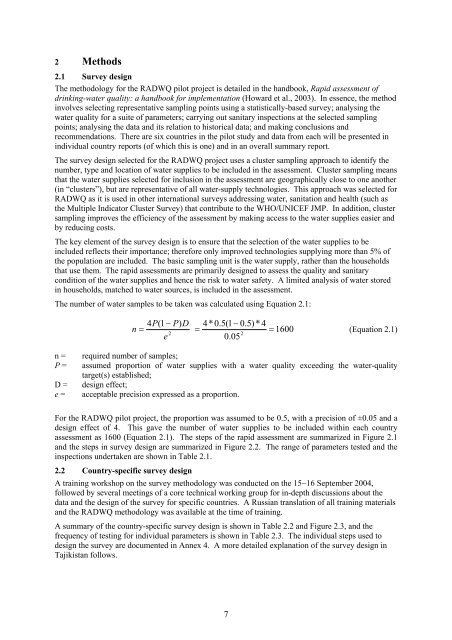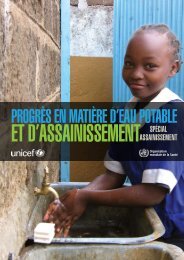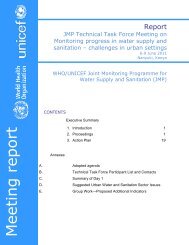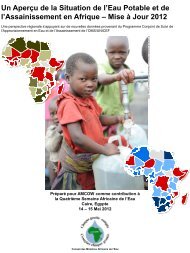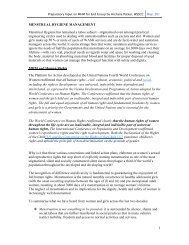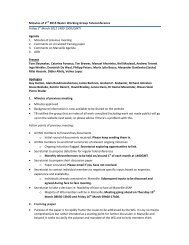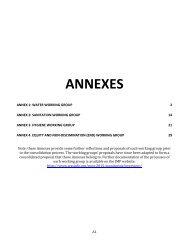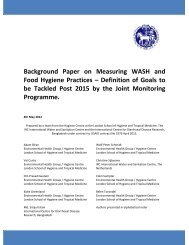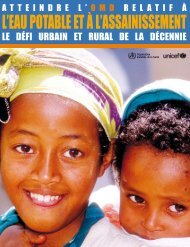rapid assessment of drinking-water quality in the republic of tajikistan
rapid assessment of drinking-water quality in the republic of tajikistan
rapid assessment of drinking-water quality in the republic of tajikistan
Create successful ePaper yourself
Turn your PDF publications into a flip-book with our unique Google optimized e-Paper software.
2 Methods<br />
2.1 Survey design<br />
The methodology for <strong>the</strong> RADWQ pilot project is detailed <strong>in</strong> <strong>the</strong> handbook, Rapid <strong>assessment</strong> <strong>of</strong><br />
<strong>dr<strong>in</strong>k<strong>in</strong>g</strong>-<strong>water</strong> <strong>quality</strong>: a handbook for implementation (Howard et al., 2003). In essence, <strong>the</strong> method<br />
<strong>in</strong>volves select<strong>in</strong>g representative sampl<strong>in</strong>g po<strong>in</strong>ts us<strong>in</strong>g a statistically-based survey; analys<strong>in</strong>g <strong>the</strong><br />
<strong>water</strong> <strong>quality</strong> for a suite <strong>of</strong> parameters; carry<strong>in</strong>g out sanitary <strong>in</strong>spections at <strong>the</strong> selected sampl<strong>in</strong>g<br />
po<strong>in</strong>ts; analys<strong>in</strong>g <strong>the</strong> data and its relation to historical data; and mak<strong>in</strong>g conclusions and<br />
recommendations. There are six countries <strong>in</strong> <strong>the</strong> pilot study and data from each will be presented <strong>in</strong><br />
<strong>in</strong>dividual country reports (<strong>of</strong> which this is one) and <strong>in</strong> an overall summary report.<br />
The survey design selected for <strong>the</strong> RADWQ project uses a cluster sampl<strong>in</strong>g approach to identify <strong>the</strong><br />
number, type and location <strong>of</strong> <strong>water</strong> supplies to be <strong>in</strong>cluded <strong>in</strong> <strong>the</strong> <strong>assessment</strong>. Cluster sampl<strong>in</strong>g means<br />
that <strong>the</strong> <strong>water</strong> supplies selected for <strong>in</strong>clusion <strong>in</strong> <strong>the</strong> <strong>assessment</strong> are geographically close to one ano<strong>the</strong>r<br />
(<strong>in</strong> “clusters”), but are representative <strong>of</strong> all <strong>water</strong>-supply technologies. This approach was selected for<br />
RADWQ as it is used <strong>in</strong> o<strong>the</strong>r <strong>in</strong>ternational surveys address<strong>in</strong>g <strong>water</strong>, sanitation and health (such as<br />
<strong>the</strong> Multiple Indicator Cluster Survey) that contribute to <strong>the</strong> WHO/UNICEF JMP. In addition, cluster<br />
sampl<strong>in</strong>g improves <strong>the</strong> efficiency <strong>of</strong> <strong>the</strong> <strong>assessment</strong> by mak<strong>in</strong>g access to <strong>the</strong> <strong>water</strong> supplies easier and<br />
by reduc<strong>in</strong>g costs.<br />
The key element <strong>of</strong> <strong>the</strong> survey design is to ensure that <strong>the</strong> selection <strong>of</strong> <strong>the</strong> <strong>water</strong> supplies to be<br />
<strong>in</strong>cluded reflects <strong>the</strong>ir importance; <strong>the</strong>refore only improved technologies supply<strong>in</strong>g more than 5% <strong>of</strong><br />
<strong>the</strong> population are <strong>in</strong>cluded. The basic sampl<strong>in</strong>g unit is <strong>the</strong> <strong>water</strong> supply, ra<strong>the</strong>r than <strong>the</strong> households<br />
that use <strong>the</strong>m. The <strong>rapid</strong> <strong>assessment</strong>s are primarily designed to assess <strong>the</strong> <strong>quality</strong> and sanitary<br />
condition <strong>of</strong> <strong>the</strong> <strong>water</strong> supplies and hence <strong>the</strong> risk to <strong>water</strong> safety. A limited analysis <strong>of</strong> <strong>water</strong> stored<br />
<strong>in</strong> households, matched to <strong>water</strong> sources, is <strong>in</strong>cluded <strong>in</strong> <strong>the</strong> <strong>assessment</strong>.<br />
The number <strong>of</strong> <strong>water</strong> samples to be taken was calculated us<strong>in</strong>g Equation 2.1:<br />
4P(1<br />
P)<br />
D 4*0.5(1 0.5) * 4<br />
n 1600<br />
(Equation 2.1)<br />
2<br />
2<br />
e<br />
0.05<br />
n =<br />
P =<br />
D =<br />
e =<br />
required number <strong>of</strong> samples;<br />
assumed proportion <strong>of</strong> <strong>water</strong> supplies with a <strong>water</strong> <strong>quality</strong> exceed<strong>in</strong>g <strong>the</strong> <strong>water</strong>-<strong>quality</strong><br />
target(s) established;<br />
design effect;<br />
acceptable precision expressed as a proportion.<br />
For <strong>the</strong> RADWQ pilot project, <strong>the</strong> proportion was assumed to be 0.5, with a precision <strong>of</strong> ±0.05 and a<br />
design effect <strong>of</strong> 4. This gave <strong>the</strong> number <strong>of</strong> <strong>water</strong> supplies to be <strong>in</strong>cluded with<strong>in</strong> each country<br />
<strong>assessment</strong> as 1600 (Equation 2.1). The steps <strong>of</strong> <strong>the</strong> <strong>rapid</strong> <strong>assessment</strong> are summarized <strong>in</strong> Figure 2.1<br />
and <strong>the</strong> steps <strong>in</strong> survey design are summarized <strong>in</strong> Figure 2.2. The range <strong>of</strong> parameters tested and <strong>the</strong><br />
<strong>in</strong>spections undertaken are shown <strong>in</strong> Table 2.1.<br />
2.2 Country-specific survey design<br />
A tra<strong>in</strong><strong>in</strong>g workshop on <strong>the</strong> survey methodology was conducted on <strong>the</strong> 1516 September 2004,<br />
followed by several meet<strong>in</strong>gs <strong>of</strong> a core technical work<strong>in</strong>g group for <strong>in</strong>-depth discussions about <strong>the</strong><br />
data and <strong>the</strong> design <strong>of</strong> <strong>the</strong> survey for specific countries. A Russian translation <strong>of</strong> all tra<strong>in</strong><strong>in</strong>g materials<br />
and <strong>the</strong> RADWQ methodology was available at <strong>the</strong> time <strong>of</strong> tra<strong>in</strong><strong>in</strong>g.<br />
A summary <strong>of</strong> <strong>the</strong> country-specific survey design is shown <strong>in</strong> Table 2.2 and Figure 2.3, and <strong>the</strong><br />
frequency <strong>of</strong> test<strong>in</strong>g for <strong>in</strong>dividual parameters is shown <strong>in</strong> Table 2.3. The <strong>in</strong>dividual steps used to<br />
design <strong>the</strong> survey are documented <strong>in</strong> Annex 4. A more detailed explanation <strong>of</strong> <strong>the</strong> survey design <strong>in</strong><br />
Tajikistan follows.<br />
7


